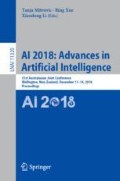Abstract
Classification tasks become more challenging when having the curse of dimensionality issue. Recently, there has been an increasing number of datasets with thousands of features. Some classification algorithms often need feature selection to avoid the curse of dimensionality. Genetic programming (GP) has shown success in classification tasks. GP does not require to do feature selection because of its built-in capability to automatically select informative features. However, GP-based methods are often computationally intensive to achieve a good classification accuracy. Based on perspectives from granular computing (GrC), this paper proposes a new approach to linking features hierarchically for GP-based classification. Experiments on seven high-dimensional datasets show the effectiveness of the proposed algorithm in terms of saving training time and enhancing the classification accuracy, compared to baseline methods.
Access this chapter
Tax calculation will be finalised at checkout
Purchases are for personal use only
Notes
- 1.
# indicates cardinality.
- 2.
References
Bargiela, A., Pedrycz, W.: Granular computing. In: Handbook in Computational Intelligence. Fuzzy Logic, Systems, Artificial Neural Networks, and Learning Systems, vol. 1, pp. 43–66. World Scientific (2016)
Cao, J., Lin, Z., Huang, G.B., Liu, N.: Voting based extreme learning machine. Inf. Sci. 185(1), 66–77 (2012)
Cervante, L., Xue, B., Shang, L., Zhang, M.: A dimension reduction approach to classification based on particle swarm optimisation and rough set theory. In: Thielscher, M., Zhang, D. (eds.) AI 2012. LNCS (LNAI), vol. 7691, pp. 313–325. Springer, Heidelberg (2012). https://doi.org/10.1007/978-3-642-35101-3_27
Deng, Z., Zhu, X., Cheng, D., Zong, M., Zhang, S.: Efficient knn classification algorithm for big data. Neurocomputing 195, 143–148 (2016)
Espejo, P.G., Ventura, S., Herrera, F.: A survey on the application of genetic programming to classification. IEEE Trans. Syst. Man Cybern. Part C (Appl. Rev.) 40(2), 121–144 (2010)
Fleury, A., Vacher, M., Noury, N.: SVM-based multimodal classification of activities of daily living in health smart homes: sensors, algorithms, and first experimental results. IEEE Trans. Inf. Technol. Biomed. 14(2), 274–283 (2010)
Joshi, A., Dangra, J., Rawat, M.: A decision tree based classification technique for accurate heart disease classification and prediction. Int. J. Technol. Res. Manag. 3, 1–4 (2016)
Luna, J.M., Pechenizkiy, M., del Jesus, M.J., Ventura, S.: Mining context-aware association rules using grammar-based genetic programming. IEEE Trans. Cybern. (2017)
Murphy, K.P.: Naive Bayes Classifiers. University of British Columbia (2006)
Nguyen, H.B., Xue, B., Andreae, P.: A hybrid GA-GP method for feature reduction in classification. In: Shi, Y., et al. (eds.) SEAL 2017. LNCS, vol. 10593, pp. 591–604. Springer, Cham (2017). https://doi.org/10.1007/978-3-319-68759-9_48
Poli, R., Langdon, W., McPhee, N.: A Field Guide to Genetic Programming (2008)
Sáez, J.A., Galar, M., Luengo, J., Herrera, F.: Tackling the problem of classification with noisy data using multiple classifier systems: analysis of the performance and robustness. Inf. Sci. 247, 1–20 (2013)
Sokolova, M., Lapalme, G.: A systematic analysis of performance measures for classification tasks. Inf. Process. Manag. 45(4), 427–437 (2009)
Svetnik, V., Liaw, A., Tong, C., Culberson, J.C., Sheridan, R.P., Feuston, B.P.: Random forest: a classification and regression tool for compound classification and QSAR modeling. J. Chem. Inf. Comput. Sci. 43(6), 1947–1958 (2003)
Thearling, K.: An Introduction to Data Mining (2017)
Tran, B., Xue, B., Zhang, M.: Genetic programming for feature construction and selection in classification on high-dimensional data. Memetic Comput. 8(1), 3–15 (2016)
Tran, B., Xue, B., Zhang, M.: Using feature clustering for GP-based feature construction on high-dimensional data. In: McDermott, J., Castelli, M., Sekanina, L., Haasdijk, E., García-Sánchez, P. (eds.) EuroGP 2017. LNCS, vol. 10196, pp. 210–226. Springer, Cham (2017). https://doi.org/10.1007/978-3-319-55696-3_14
Wang, G., Yang, J., Xu, J.: Granular computing: from granularity optimization to multi-granularity joint problem solving. Granul. Comput. 2(3), 105–120 (2017)
Yang, H.J., Roe, B.P., Zhu, J.: Studies of stability and robustness for artificial neural networks and boosted decision trees. Nucl. Instrum. Methods Phys. Res. Sect. A: Accel. Spectrometers Detect. Assoc. Equip. 574(2), 342–349 (2007)
Yao, J.: Novel Developments in Granular Computing: Applications for Advanced Human Reasoning and Soft Computation. IGI Global (2010)
Yao, Y.: A triarchic theory of granular computing. Granul. Comput. 1(2), 145–157 (2016)
Zhang, G.P.: Neural networks for classification: a survey. IEEE Trans. Syst. Man Cybern. Part C (Appl. Rev.) 30(4), 451–462 (2000)
Zhu, Z., Ong, Y.S., Dash, M.: Markov blanket-embedded genetic algorithm for gene selection. Pattern Recognit. 40(11), 3236–3248 (2007)
Acknowledgement
This work was supported in part by the Marsden Fund of New Zealand Government under Contracts VUW1209, VUW1509 and VUW1615, Huawei Industry Fund E2880/3663, Natural Science Foundation of Jiangsu, China BK20161406, and the University Research Fund at Victoria University of Wellington 209862/3580, and 213150/3662.
Author information
Authors and Affiliations
Corresponding author
Editor information
Editors and Affiliations
Rights and permissions
Copyright information
© 2018 Springer Nature Switzerland AG
About this paper
Cite this paper
Pei, W., Xue, B., Shang, L., Zhang, M. (2018). Genetic Programming Based on Granular Computing for Classification with High-Dimensional Data. In: Mitrovic, T., Xue, B., Li, X. (eds) AI 2018: Advances in Artificial Intelligence. AI 2018. Lecture Notes in Computer Science(), vol 11320. Springer, Cham. https://doi.org/10.1007/978-3-030-03991-2_58
Download citation
DOI: https://doi.org/10.1007/978-3-030-03991-2_58
Published:
Publisher Name: Springer, Cham
Print ISBN: 978-3-030-03990-5
Online ISBN: 978-3-030-03991-2
eBook Packages: Computer ScienceComputer Science (R0)

